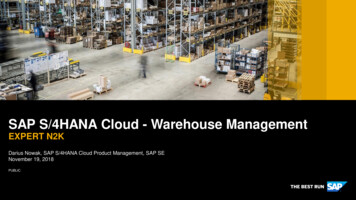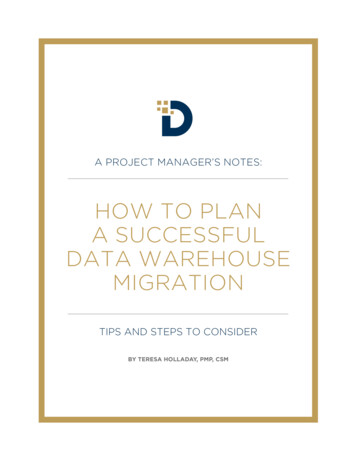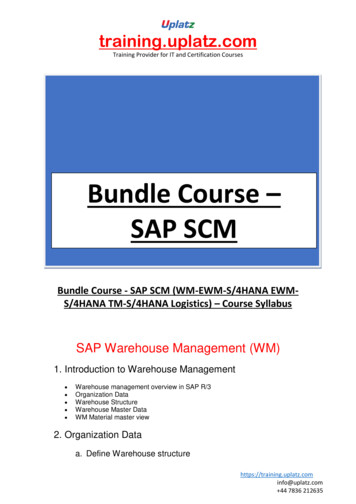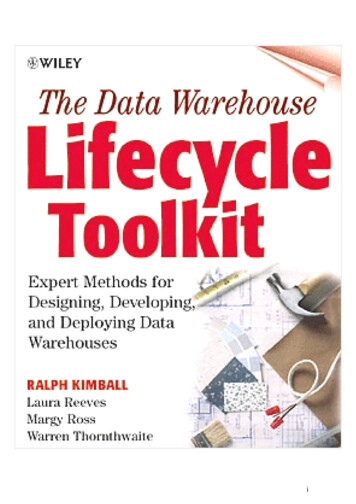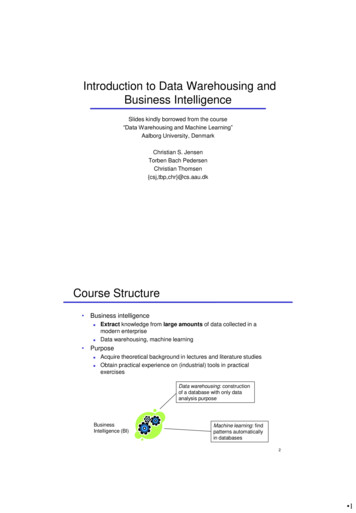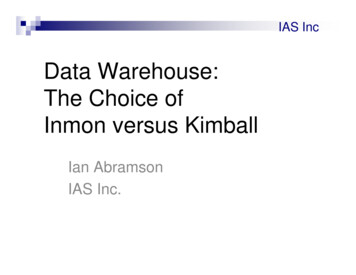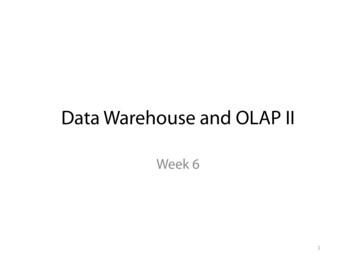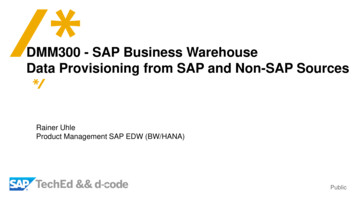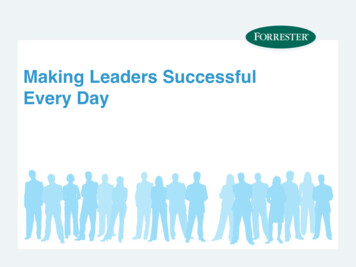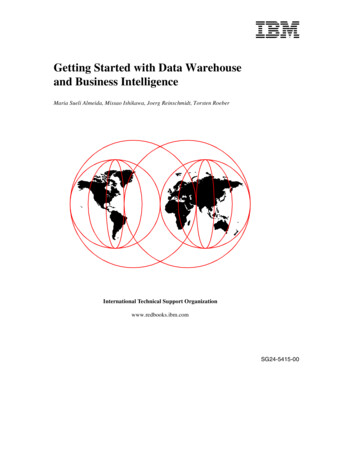
Transcription
Getting Started with Data Warehouseand Business IntelligenceMaria Sueli Almeida, Missao Ishikawa, Joerg Reinschmidt, Torsten RoeberInternational Technical Support Organizationwww.redbooks.ibm.comSG24-5415-00
SG24-5415-00International Technical Support OrganizationGetting Started with Data Warehouseand Business IntelligenceAugust 1999
Take Note!Before using this information and the product it supports, be sure to read the general information inAppendix B, “Special Notices” on page 225.First Edition (August 1999)This edition applies to Version 5, Release 1of DB2 Server for VSE & VM Program Number 5648-158,Version 5, Release 1of DB2 Server for OS/390 Program Number 5655-DB2, Version 5.2 of IBM VisualWarehouse, Version 1.0.1 of IBM DB2 OLAP Server, Version 2.1.2 of IBM Intelligent Miner for Data,Version 5.2 of IBM DB2 UDB for NT, Version 2.1.1of IBM DB2 DataJoiner Classic Connect, Version2.1.3 of IBM DB2 Datajoiner for use with the Windows NT operating system, and Version 5.2 of IBMDB2 UDB for AIX, Version 2.1.2 of IBM Intelligent MIner for Data, Version 2.1.3 of IBM DB2 DataJoiner,Version 2.1.1 of IBM DB2 DataJoiner Classic Connect for use with the AIX Version 4.3.1 OperatingSystem, CrossAccess VSE V4.1.Comments may be addressed to:IBM Corporation, International Technical Support OrganizationDept. QXXE Building 80-E2650 Harry RoadSan Jose, California 95120-6099When you send information to IBM, you grant IBM a non-exclusive right to use or distribute theinformation in any way it believes appropriate without incurring any obligation to you. Copyright International Business Machines Corporation 1999. All rights reservedNote to U.S Government Users – Documentation related to restricted rights – Use, duplication or disclosure issubject to restrictions set forth in GSA ADP Schedule Contract with IBM Corp.
ContentsFigures . . . . . . . . . . . . . . . . . . . . . . . . . . . . . . . . . . . . . . . . . . . . . . . . . . . viiTables. . . . . . . . . . . . . . . . . . . . . . . . . . . . . . . . . . . . . . . . . . . . . . . . . . . . .ixPreface . . . . . . . . . . . . . . . . . . . . . . . . . . . . . . . . . . . . . . . . . . . . . . . . . . . .xiThe Team That Wrote This Redbook . . . . . . . . . . . . . . . . . . . . . . . . . . . . . . . . . xiComments Welcome . . . . . . . . . . . . . . . . . . . . . . . . . . . . . . . . . . . . . . . . . . . . xiiiChapter 1. What is BI ? . . . . . . . . . . . . . . . . . . . . . . . . . . .1.1 The Evolution of Business Information Systems . . . . . . .1.1.1 First-Generation: Host-Based Query and Reporting1.1.2 Second-Generation: Data Warehousing . . . . . . . . .1.1.3 Third-Generation: Business Intelligence . . . . . . . . .1.2 Why Do You Need Business Intelligence ? . . . . . . . . . . .1.3 What Do You Need for Business Intelligence ? . . . . . . .1.4 Business Driving Forces . . . . . . . . . . . . . . . . . . . . . . . . .1.5 Business Intelligence Requirements . . . . . . . . . . . . . . . .1.6 The IBM Business Intelligence Product Set . . . . . . . . . .1.6.1 Business Intelligence Applications . . . . . . . . . . . . .1.6.2 Decision Support Tools. . . . . . . . . . . . . . . . . . . . . .1.7 The Challenge of Data Diversity . . . . . . . . . . . . . . . . . . . .1. .1. .1. .2. .2. .5. .5. .7. .8. .8. .9. 10. 14Chapter 2. ITSO Scenario . . . . . .2.1 The Environment . . . . . . . . . . .2.1.1 Database Server . . . . . . .2.1.2 Visual Warehouse . . . . . .2.1.3 Communication Gateways2.1.4 Data Analysis Tools . . . . .2.2 The Data . . . . . . . . . . . . . . . . .2.2.1 Sales Information . . . . . . .2.2.2 Article Information . . . . . .2.2.3 Organization Information .2.3 Data Warehouse for OLAP . . . . 17. 17. 18. 19. 19. 20. 20. 21. 21. 23. 24Chapter 3. The Products and Their Construction . .3.1 The DataJoiner Product . . . . . . . . . . . . . . . . . . . .3.1.1 DataJoiner Classic Connect Component. . . .3.1.2 DataJoiner Classic Connect Architecture . . .3.2 CrossAccess . . . . . . . . . . . . . . . . . . . . . . . . . . . .3.2.1 CrossAccess Architecture. . . . . . . . . . . . . . .3.3 Visual Warehouse: Server and Agent . . . . . . . . . . 29. 29. 29. 30. 36. 36. 42 Copyright IBM Corp. 1999.iii
iv3.3.1 Data Sources Supported . . . . . . . . . . . . . . . . . . . . .3.3.2 Data Stores Supported . . . . . . . . . . . . . . . . . . . . . . .3.3.3 End User Query Tools . . . . . . . . . . . . . . . . . . . . . . .3.3.4 Meta Data Management . . . . . . . . . . . . . . . . . . . . . .3.3.5 The Architecture of Visual Warehouse . . . . . . . . . . .3.4 Intelligent Miner for Data . . . . . . . . . . . . . . . . . . . . . . . . .3.4.1 Overview of the Intelligent Miner. . . . . . . . . . . . . . . .3.4.2 Working with Databases . . . . . . . . . . . . . . . . . . . . . .3.4.3 The User Interface . . . . . . . . . . . . . . . . . . . . . . . . . .3.4.4 Data Preparation Functions . . . . . . . . . . . . . . . . . . .3.4.5 Statistical and Mining Functions . . . . . . . . . . . . . . . .3.4.6 Processing IM Functions . . . . . . . . . . . . . . . . . . . . .3.4.7 Creating and Visualizing the Results . . . . . . . . . . . .3.4.8 Creating Data Mining Operations . . . . . . . . . . . . . . .3.5 DB2 OLAP Server . . . . . . . . . . . . . . . . . . . . . . . . . . . . . .3.5.1 The General Architecture . . . . . . . . . . . . . . . . . . . . .3.5.2 Architecture and Concepts of DB2 OLAP Server and3.5.3 Supported Platforms and RDBMSs . . . . . . . . . . . . . .3.5.4 Wired for OLAP Server . . . . . . . . . . . . . . . . . . . . . . .3.6 DB2 Connect . . . . . . . . . . . . . . . . . . . . . . . . . . . . . . . . . .3.7 IBM e-Network Communication Server Host-on Demand .3.7.1 Communication Server . . . . . . . . . . . . . . . . . . . . . . .3.7.2 Host-on Demand . . . . . . . . . . . . . . . . . . . . . . . . . . .3.8 Net.Data and Its Architecture . . . . . . . . . . . . . . . . . . . . . .3.9 Web Server . . . . . . . . . . . . . . . . . . . . . . . . . . . . . . . . . . .Essbase . 42. 42. 43. 43. 43. 45. 45. 45. 46. 46. 47. 48. 49. 50. 51. 53. 53. 57. 57. 58. 65. 65. 70. 72. 74Chapter 4. Data Communication . . . . . . . . . . .4.1 Communication Protocols . . . . . . . . . . . . . . .4.1.1 TCP/IP . . . . . . . . . . . . . . . . . . . . . . . . .4.1.2 APPC . . . . . . . . . . . . . . . . . . . . . . . . . .4.2 Data Exchange Protocols . . . . . . . . . . . . . .4.2.1 DRDA Remote Unit of Work (RUW) . . .4.2.2 DRDA Distributed Unit of Work (DUW) .4.2.3 Distributed Request (DR) . . . . . . . . . . .4.2.4 Private Protocols . . . . . . . . . . . . . . . . .4.2.5 Nonrelational Access . . . . . . . . . . . . . . 77. 78. 78. 89. 96. 96. 96. 97. 97. 97Chapter 5. Implementation . . . . . . . . . . . . . . . . . . . . . . . . . .5.1 OS/390 Environment . . . . . . . . . . . . . . . . . . . . . . . . . . . . .5.1.1 IMS/ESA Environment Configuration . . . . . . . . . . . . .5.1.2 DataJoiner Classic Connect Configuration . . . . . . . . .5.1.3 Network Communication Protocol Configurations . . . .5.1.4 Configuring Data Server Communications on OS/390. . 99. . 99. . 99. 100. 102. 104Getting Started with Data Warehouse and Business Intelligence.
5.1.5 Configuring an AIX Classic Connect Client . .5.1.6 Mapping Non-Relational Data (VSAM) . . . . .5.1.7 Mapping Non-Relational Data (IMS) . . . . . . .5.1.8 DataJoiner Connectivity . . . . . . . . . . . . . . . .5.1.9 Accessing Your Data . . . . . . . . . . . . . . . . . .5.2 VM/VSE . . . . . . . . . . . . . . . . . . . . . . . . . . . . . . . .5.2.1 Installation . . . . . . . . . . . . . . . . . . . . . . . . . .5.2.2 Product Installation and Configuration . . . . . 106. 107. 115. 123. 127. 129. 130. 132Chapter 6. The Data Warehouse Definitions . . . . . . . . . . . . .6.1 The Data Acquisition Process. . . . . . . . . . . . . . . . . . . . . . .6.1.1 The First Dimension . . . . . . . . . . . . . . . . . . . . . . . . . .6.1.2 The Second Dimension . . . . . . . . . . . . . . . . . . . . . . .6.2 Technical Implementation of the Data Acquisition Process . 167. 167. 167. 170. 174.Appendix A. The OS/390 Environment . . . . . . . . . . . . . . . . . . . . . . . . . . 177A.1 The IMS - DBCTL Environment . . . . . . . . . . . . . . . . . . . . . . . . . . . . . . . 177A.2 The DB/DC Environment . . . . . . . . . . . . . . . . . . . . . . . . . . . . . . . . . . . . 178A.3 Configuring the DBCTL Environment . . . . . . . . . . . . . . . . . . . . . . . . . . . 179A.3.1 Create Stage 1 Input for DBCTL System . . . . . . . . . . . . . . . . . . . . 179A.3.2 Run the IMS System Definition STAGE 1. . . . . . . . . . . . . . . . . . . . 182A.3.3 Run the IMS System Definition STAGE 2. . . . . . . . . . . . . . . . . . . . 184A.3.4 Create DFSPBxxx Member . . . . . . . . . . . . . . . . . . . . . . . . . . . . . . 184A.3.5 Create IMS DBCTL Started Procedure. . . . . . . . . . . . . . . . . . . . . . 186A.3.6 Create IMS DL/I Started Procedure . . . . . . . . . . . . . . . . . . . . . . . . 191A.3.7 Create IMS DBRC Started Procedure . . . . . . . . . . . . . . . . . . . . . . 192A.3.8 Allocate RECON Data Sets . . . . . . . . . . . . . . . . . . . . . . . . . . . . . . 194A.3.9 Register DBRC Information . . . . . . . . . . . . . . . . . . . . . . . . . . . . . . 196A.4 Data Creation . . . . . . . . . . . . . . . . . . . . . . . . . . . . . . . . . . . . . . . . . . . . . 199A.4.1 IMS Definitions . . . . . . . . . . . . . . . . . . . . . . . . . . . . . . . . . . . . . . . . 199A.4.2 DB2 Definitions . . . . . . . . . . . . . . . . . . . . . . . . . . . . . . . . . . . . . . . . 204A.4.3 VSAM Definitions . . . . . . . . . . . . . . . . . . . . . . . . . . . . . . . . . . . . . . 214A.4.4 Classic Connect Definitions . . . . . . . . . . . . . . . . . . . . . . . . . . . . . . 216A.5 Hints and Tips . . . . . . . . . . . . . . . . . . . . . . . . . . . . . . . . . . . . . . . . . . . . . 223A.5.1 TCP/IP for MVS Environment Setup. . . . . . . . . . . . . . . . . . . . . . . . 223A.5.2 IMS Environment Setup . . . . . . . . . . . . . . . . . . . . . . . . . . . . . . . . . 223A.5.3 Classic Connect Setup (for Data Server) . . . . . . . . . . . . . . . . . . . . 223A.5.4 Classic Connect Setup (for Client) . . . . . . . . . . . . . . . . . . . . . . . . . 224Appendix B. Special Notices . . . . . . . . . . . . . . . . . . . . . . . . . . . . . . . . . . 225Appendix C. Related Publications. . . . . . . . . . . . . . . . . . . . . . . . . . . . . . 229C.1 International Technical Support Organization Publications . . . . . . . . . . 229C.2 Redbooks on CD-ROMs . . . . . . . . . . . . . . . . . . . . . . . . . . . . . . . . . . . . . 230v
C.3 Other Publications . . . . . . . . . . . . . . . . . . . . . . . . . . . . . . . . . . . . . . . . . 230How to Get ITSO Redbooks . . . . . . . . . . . . . . . . . . . . . . . . . . . . . . . . . 233IBM Redbook Fax Order Form . . . . . . . . . . . . . . . . . . . . . . . . . . . . . . . . . . . . 234List of Abbreviations. . . . . . . . . . . . . . . . . . . . . . . . . . . . . . . . . . . . . . . 235Index . . . . . . . . . . . . . . . . . . . . . . . . . . . . . . . . . . . . . . . . . . . . . . . . . . . 239ITSO Redbook Evaluation . . . . . . . . . . . . . . . . . . . . . . . . . . . . . . . . . . . 243viGetting Started with Data Warehouse and Business Intelligence
35.36.37.38.39.40.IBM Business Intelligence Structure . . . . . . . . . . . . . . . . . . . . . . . . . . . . . . 4IBM Business Intelligence Product Set . . . . . . . . . . . . . . . . . . . . . . . . . . . . 9The ITSO Environment . . . . . . . . . . . . . . . . . . . . . . . . . . . . . . . . . . . . . . . 18Classic Connect Architecture . . . . . . . . . . . . . . . . . . . . . . . . . . . . . . . . . . . 33Classic Connect Architecture with Enterprise Server . . . . . . . . . . . . . . . . 34Data Mapper Workflow . . . . . . . . . . . . . . . . . . . . . . . . . . . . . . . . . . . . . . . 35CrossAccess Architecture . . . . . . . . . . . . . . . . . . . . . . . . . . . . . . . . . . . . . 39CrossAccess Architecture with Enterprise Server . . . . . . . . . . . . . . . . . . . 40CrossAccess Data Mapper Workflow . . . . . . . . . . . . . . . . . . . . . . . . . . . . 41Sample Clustering Visualization . . . . . . . . . . . . . . . . . . . . . . . . . . . . . . . . 50Sequence-Settings Window. . . . . . . . . . . . . . . . . . . . . . . . . . . . . . . . . . . . 51Architecture Building Blocks of an OLAP Solution. . . . . . . . . . . . . . . . . . . 53Hyperion Essbase and DB2 OLAP Server Architectures. . . . . . . . . . . . . . 56DB2 Connect Enterprise Edition . . . . . . . . . . . . . . . . . . . . . . . . . . . . . . . . 59DB2 Connect Personal Edition . . . . . . . . . . . . . . . . . . . . . . . . . . . . . . . . . 60Net.Data Architecture . . . . . . . . . . . . . . . . . . . . . . . . . . . . . . . . . . . . . 74TCP/IP Architecture Model: Layers and Protocols. . . . . . . . . . . . . . . . . . . 80Assigned Classes of IP Addresses . . . . . . . . . . . . . . . . . . . . . . . . . . . . . . 81Class A Address without Subnets . . . . . . . . . . . . . . . . . . . . . . . . . . . . . . . 83Class A Address with Subnet Mask and Subnet Address . . . . . . . . . . . . . 84Format of an IP Datagram Header. . . . . . . . . . . . . . . . . . . . . . . . . . . . 86Direct and Indirect Routing . . . . . . . . . . . . . . . . . . . . . . . . . . . . . . . . . . . . 87Routing Table Scenario . . . . . . . . . . . . . . . . . . . . . . . . . . . . . . . . . . . . . . . 88IP Routing Table Entries Example . . . . . . . . . . . . . . . . . . . . . . . . . . . . . . . 88IP Routing Algorithm (with Subnets) . . . . . . . . . . . . . . . . . . . . . . . . . . . . . 89TCP/IP Communications Template and Worksheet . . . . . . . . . . . . . . . . 104Relationship of DJCC Parameters . . . . . . . . . . . . . . . . . . . . . . . . . . . . . . 105Example of Classic Connect Configuration file, djxclassic2.cfg . . . . . . . . 106Example of .profile . . . . . . . . . . . . . . . . . . . . . . . . . . . . . . . . . . . . . . . . . . 107Example of db2profile . . . . . . . . . . . . . . . . . . . . . . . . . . . . . . . . . . . . . . . 107Output of JOBLOG for JDXDRA . . . . . . . . . . . . . . . . . . . . . . . . . . . . . . . 127Result of ’db2 -vtf orgstruc.sql’. . . . . . . . . . . . . . . . . . . . . . . . . . . . . . . . . 128Result of ’db2 -vtf firdb.sql’. . . . . . . . . . . . . . . . . . . . . . . . . . . . . . . . . . . . 129Result of ’db2 -vtf filstam.sql’ . . . . . . . . . . . . . . . . . . . . . . . . . . . . . . . . . . 129Sources for Dimension Table PRODUCT . . . . . . . . . . . . . . . . . . . . . . . . 168Dimension Table PRODUCT from Join of Intermediate Sources . . . . . . 170Sources for Dimension Table ORGANIZATION . . . . . . . . . . . . . . . . . . . 172Dimension Table ORGANIZATION from JOIN of Intermediate Sources . 173Example of a DBCTL Environment . . . . . . . . . . . . . . . . . . . . . . . . . . . . . 178Example of a DB/DC Environment. . . . . . . . . . . . . . . . . . . . . . . . . . . . . . 179 Copyright IBM Corp. 1999vii
41.42.43.44.viiiExample of DBD and PSB Specifications . . . . . . . . . . . . . . . . . . . . . . . . 180Example of DFSPBxxx. . . . . . . . . . . . . . . . . . . . . . . . . . . . . . . . . . . . . . . 184Example of IMS Started Procedure Parameter . . . . . . . . . . . . . . . . . . . . 186Example of RECON Records Registration . . . . . . . . . . . . . . . . . . . . . . . 197Getting Started with Data Warehouse and Business Intelligence
Tables1.2.3.4.5.6.7.8.DB2 Tables on SC19M . . . . . . . . . . . . . . . . . . . . . . . . . . . . . . . . . . . . . . . 24DL/I ’Tables’ derived through CrossAccess . . . . . . . . . . . . . . . . . . . . . . . . 26VSAM ’Tables’ derived through CrossAccess . . . . . . . . . . . . . . . . . . . . . . 27DB2 Table in Windows NT database SJNTADD . . . . . . . . . . . . . . . . . . . . 27VSE User IDs and ICCF Libraries . . . . . . . . . . . . . . . . . . . . . . . . . . . . . . 130VSE Partition Allocation and Usage. . . . . . . . . . . . . . . . . . . . . . . . . . . . . 131VTAM Configuration Members. . . . . . . . . . . . . . . . . . . . . . . . . . . . . . . . . 133Table-Dbspace-Pool Relation . . . . . . . . . . . . . . . . . . . . . . . . . . . . . . . . . 154 Copyright IBM Corp. 1999ix
xGetting Started with Data Warehouse and Business Intelligence
PrefaceThis redbook describes an operating environment that supports DataWarehousing and BI solutions on all available platforms. The book describeshow this environment was established. This project was carried out at theITSO San Jose Center. DRDA over TCP/IP, DataJoiner Classic Connect,Cross Access for VSE, and Datajoiner are used to create this environment.The objective of creating this environment was to have a base BI environmentto support Data Warehouse, OLAP, and Data Mining solutions. This book isnot intended to show how to set up and configure the different products used;some of these have been covered in previous product-specific redbooks.This redbook is intended to be used in conjunction with the redbooks:Intelligent Miner for Data: Enhance Your Business Intelligence, SG24-5422and My Mother Thinks I'm a DBA! Cross-Platform, Multi-Vendor, DistributedRelational Data Replication with IBM DB2 DataPropagator and IBM DataJoinerMade Easy!, SG24-5463. Future redbooks will enhance and exploit thisenvironment.The Team That Wrote This RedbookThis redbook was produced by a team of specialists from around the worldworking at the International Technical Support Organization San Jose Center.Maria Sueli Almeida is a Certified I/T Specialist - Systems Enterprise Data,and is currently a specialist in DB2 for OS/390 and Distributed RelationalDatabase System (DRDS) at the International Technical SupportOrganization, San Jose Center. Before joining the ITSO in 1998, Maria Sueliworked at IBM Brazil assisting customers and IBM technical professionals onDB2, data sharing, database design, performance, and DRDA connectivity.Missao Ishikawa is an Advisory I/T Specialist, supporting Intelligent Minerfor OS/390 and Domino for S/390 in IBM Japan. He joined IBM in 1987 andhas been working in various areas of technical support. He has worked for1998 Nagano Olympics as a DB2 specialist, supporting all aspects of DB2 forOS/390.Joerg Reinschmidt is an Information Mining Specialist at the InternationalTechnical Support Organization, San Jose Center. He writes extensively andteaches IBM classes worldwide on all areas of DB2 Universal Database,Internet access to legacy data, Information Mining, and KnowledgeManagement. Before joining the ITSO in 1998, Joerg worked in the Solution Copyright IBM Corp. 1999xi
Partnership Center in Germany as a DB2 Specialist, supporting independentsoftware vendors (ISVs) to port their applications to use the IBM datamanagement products.Torsten Roeber is a Software Service Specialist with IBM Germany. He hasseveral years of experience with VSE/ESA and DB2 (SQL/DS) for VSE andVM. During the last two years he has focused on distributed database issuesin the VM/VSE and workstation environment.Thanks to the following people for their invaluable contributions to this project:Paolo BruniInternational Technical Support Organization, San Jose CenterScott ChenInternational Technical Support Organization, San Jose CenterThomas GrohInternational Technical Support Organization, San Jose CenterRick LongInternational Technical Support Organization, San Jose CenterWiliam Tomio KanegaeIBM BrazilWilhelm MildIBM GermanyThanks also to the professionals from Cross Access Corporation, forsupporting and writing about the CrossAccess product.xiiGetting Started with Data Warehouse and Business Intelligence
Comments WelcomeYour comments are important to us!We want our redbooks to be as helpful as possible. Please send us yourcomments about this or other redbooks in one of the following ways: Fax the evaluation form found in “ITSO Redbook Evaluation” on page 243to the fax number shown on the form. Use the electronic evaluation form found on the Redbooks Web sites:For Internet usersFor IBM Intranet m.com Send us a note at the following address:redbook@us.ibm.comxiii
xivGetting Started with Data Warehouse and Business Intelligence
Chapter 1. What is BI ?When reading about business intelligence (BI), one of the global definitionsyou may see is the one found on the IBM Business Intelligence Web page:"Business intelligence means using your data assets to make betterbusiness decisions. It is about access, analysis, and uncovering newopportunities."Many of the concepts of business intelligence are not new, but have evolvedand been refined based on experience gained from early host-basedcorporate information systems, and more recently, from data warehousingapplications.Given the increasing competition in today’s tough business climate, it is vitalthat organizations provide cost-effective and rapid access to businessinformation for a wide range of business users, if these organizations are tosurvive into the new millennium. The solution to this issue is a businessintelligence system, which provides a set of technologies and products forsupplying users with the information they need to answer business questions,and make tactical and strategic business decisions.1.1 The Evolution of Business Information SystemsInevitably the first question that arises when describing the objectives of abusiness intelligence system is, "Does a data warehouse have the sameobjectives and provide the same capabilities as a business intelligencesystem?" A similar question arose when data warehouses were firstintroduced, "Is a data warehouse similar to the corporate information systemsand information centers we built in the past?" Although a quick and simpleanswer to both questions is "yes", closer examination shows that, just asthere are important differences between a warehouse and early corporateinformation systems and information centers, there are also importantdifferences between a business intelligence system and a data warehouse.1.1.1 First-Generation: Host-Based Query and ReportingEarly business information systems employed batch applications to providebusiness users with the information they needed. The output from theseapplications typically involved huge volumes of paper that users had to wadethrough to get the answers they needed to business questions. The advent ofterminal-driven time-sharing applications provided more rapid access toinformation, but these systems were still cumbersome to use, and requiredaccess to complex operational databases. Copyright IBM Corp. 19991
This first generation of business information systems could, therefore, only beused by information providers, such as business analysts, who had anintimate knowledge of the data and extensive computer experience.Information consumers, like business executives and business managers,could rarely use these early systems, and instead had to rely on informationproviders to answer their questions and supply them with the information theyneeded.1.1.2 Second-Generation: Data WarehousingThe second generation of business information systems came with datawarehousing, which provided a giant leap forward in capability. Datawarehouses have several advantages over first-generation systems: Data warehouses are designed to satisfy the needs of business users andnot day-to-day operational applications. Data warehouse information is clean and consistent, and is stored in aform business users can understand. Unlike operational systems, which contain only detailed current data, thedata warehouses can supply both historical and summarized information. The use of client/server computing provides data warehouse users withimproved user interfaces and more powerful decision support tools.1.1.3 Third-Generation: Business IntelligenceA data warehouse is still not a complete solution to the needs of businessusers. One weakness of many data warehouse solutions is that the vendorsoften focus on technology, rather than business solutions. While there is nodoubt that data warehouse vendors provide powerful products for buildingand accessing a data warehouse, these products can require a significantamount of implementation effort.The issue here is that warehouse products rarely come prepackaged forspecific industries or application areas, or address particular businessproblems. This is very much like the situation in the early days of client/servercomputing, when vendors initially provided the technology for developingoperational applications, but then quickly realized that organizations werelooking for application and business solutions, and not yet more technology.Vendors fixed this problem, with the result that today many operationalclient/server applications are built using application packages, rather thanbeing handcrafted by developers.2Getting Started with Data Warehouse and Business Intelligence
The same evolution has to happen in business information systems – vendorsmust provide application packages, and not just more technology. Onedistinguishing factor of business intelligence systems is that they focus onproviding prepackaged application solutions in addition to improvedtechnology.Another issue with data warehousing is that much of the focus is still onbuilding the data warehouse, rather than accessing it. Many organizationsseem to think that if they build a data warehouse and provide users with theright tools, the job is done. In fact, it is just beginning. Unless the informationin the warehouse is thoroughly documented and easy to access, complexitywill limit warehouse usage to the same information providers asfirst-generation systems.Business intelligence systems focus on improving the access and delivery ofbusiness information to both information providers and informationconsumers. They achieve this by providing advanced graphical- andWeb-based online analytical processing (OLAP) and information mining tools,and prepackaged applications that exploit the power of those tools. Theseapplications may need to process and analyze large volumes of informationusing a variety of different tools. A business intelligence system must,therefore, provide scalability and be able to support and integrate productsfrom multiple vendors.A business intelligence system may also simplify access to businessinformation through the use an information catalog that documents decisionsupport objects that can be employed by information consumers to answerthe main business questions that arise in everyday business operations.Some also reduce the need for information consumers to access thewarehouse at all. Instead, information consumers subscribe to theinformation they require, and the system delivers it to them at predefinedintervals through a corporate intranet or e-mail.The information stored in a data warehouse is typically sourced fromoperational databases (and in some cases external information providers).There is, however, also a considerable amount of business information kept inoffice and workgroup systems, on Web servers on corporate intranets and thepublic Internet, and in paper form on people’s desks. To solve this issue,business intelligence systems are designed to support access to all forms ofbusiness information, not only the data stored in a data warehouse. Having abusiness intelligence system does not negate the need for a data warehouse– a data warehouse is simply one of the data sources that can be handled bya business intelligence system.What is BI ?3
We see, then, that a business intelligence system is a third-generationbusiness information system that has three key advantages:1. Business intelligence systems not only support the latest informationtechnologies, but also provide prepackaged application solutions.2. Business intelligence systems focus on the access and delivery ofbusiness information to end users, and support both information providersand information consumers.3. Business intelligence systems support access to all forms of businessinformation, and not just the information stored in a data warehouse.Figure 1 gives an overall view of the IBM business intelligence structure.Figure 1. IBM Business Intelligence Structure4Getting Started with Data Warehouse and Business Intelligence
1.2 Why Do You Need Business Intelligence ?Businesses collect large quantities of data in their day-to-day operations: dataabout orders, inventory, accounts payable, point-of-sale transactions, and ofcourse, customers. In addition, businesses often acquire data, such asdemographics and mailing lists, from outside sources. Being able toconsolidate and analyze this data for be
This book is not intended to show how to set up and configure the different products used; some of these have been covered in previous product-specific redbooks. This redbook is intended to


